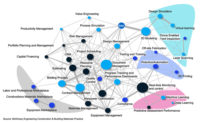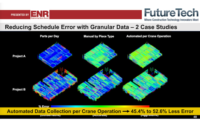Engineering technology provider Bentley Systems promises that customers’ data will always be theirs, regardless of the ongoing industry-wide migration to the cloud and the rise of AI. The company is emerging from a couple years of evolution since its September 2020 IPO with a refreshed executive team and a new outlook it offered at its annual Year in Infrastructure conference, held in Singapore October 11-12.
“You will retain all value from your data. You’ll retain all access to it,” CEO Greg Bentley told an audience of Bentley users and gathered media representatives during his keynote at the event.
While Bentley did not specifically promise to not use customer data in the training of large language models or other forms of artificial intelligence-based systems, keeping such data private would seem to run up against one of the company’s other stated goals, to use generative AI to improve project delivery.
“We must continually adapt. Readiness includes embracing data centricity,” said Bentley. “Today, we continue to transform the data in digital twins in Bentley’s cloud to infrastructure intelligence.”
Julien Moutte, Bentley’s chief technology officer who succeeds co-founder Keith Bentley, offered some examples of uses for generative AI. Possible applications of the technology in engineering include an AI that can assist in optimizing site layouts by drawing on design data from previous projects.
But the goal isn’t just to go after trendy generative AI products, but to instead leverage project data for actual useful insights, Moutte said. “How do we define infrastructure intelligence? It is the capability to leverage data, whether it is engineering data or operational data or enterprise data, to improve project delivery and asset performance.” Moutte adds that this forms the foundation of a better understanding of built assets to build better digital twins. Bentley continues to inject digital twins earlier in the construction lifecycle, adding the iTwin format to its Open Applications suite, initially with Microstation, so digital twins can be cultivated at the onset of the design process.
One of the demonstrations for the potential of data-driven “infrastructure intelligence” showcased by Bentley was a robust digital twin of Singapore, with data from sources such as Google Earth and the Singapore Land Authority’s own data collection and sensors, all collated and rendered in Unreal Engine. This view allows for deep dives into the nation’s infrastructure and performance data, such as zooming in to a color-coded view of a given building’s energy consumption, or seeing a real-time visualization of the country’s mass transit system in action.
A major draw at the conference, however, were discussions of the potential for greater use of subsurface geotechnical modeling in construction. Bentley acquired subsurface modeling firm Seequent in 2021 for $1.05 billion, and according to Greg Bentley, the potential for bringing subsurface data into digital twins and project planning has barely been tapped by the industry.
“Singapore has lots of room to grow, and subsurface modeling is a frontier of development,” Bentley said. “Subsurface digital twins and how to accurately map underground infrastructure—that’s not a digital twin that’s currently done.”
Seequent’s 3D modeling software for geoscience and underground imaging has been used for civil and environmental engineering as well as in the mining industry. And demands there for raw materials are driving new applications for subsurface mapping, said Seequent CEO Graham Grant. “New forms of energy are heavily metal consumptive. Where do we find the resources?” Grant said global battery sales are projected to grow greater than five times in the next nine years, and governments are waking up to the supply problems of this shift in demand.
Seequent also announced it was acquiring Flow State Solutions, a New Zealand-based provider of geothermal simulation software, granting Bentley a stronger presence in subsurface tools in the geothermal and underground visualization markets for both asset development and optimization.
By Jeff Yoders and Jeff Rubenstone in Singapore







Post a comment to this article
Report Abusive Comment